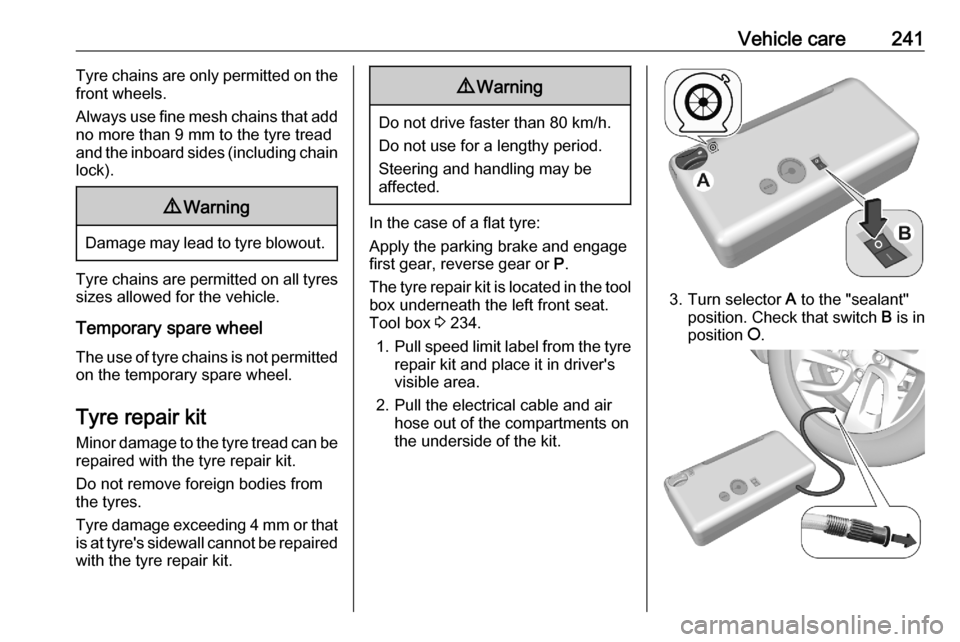steering OPEL VIVARO C 2020.25 Manual user
[x] Cancel search | Manufacturer: OPEL, Model Year: 2020.25, Model line: VIVARO C, Model: OPEL VIVARO C 2020.25Pages: 287, PDF Size: 28.79 MB
Page 236 of 287

234Vehicle careNo.Circuit1Anti-theft system or
electronic key system5Parking assist, Infotain‐
ment system, rear view
camera7Rear climate controls,
audio system amplifier8Rear window wipers10/11Central locking system12Anti-theft alarm system17Rear power outlet18Telematic unit21Interior lights, torch
charger22Interior lights, glovebox
light23Blind spot monitoring
system, door mirror
controls24Steering wheel controlsNo.Circuit25Headlight range adjust‐
ment26Seat belt reminder27Front camera, rain and
light sensor28Head-up display, front
climate controls, Info‐
tainment system
controls, gear selector30A or 30BAudio system (+
battery)31Airbag33Front power outlet35Instrument cluster36Infotainment systemVehicle tools
Tools
The tools are located in the box
underneath the left front seat.
Page 243 of 287

Vehicle care241Tyre chains are only permitted on the
front wheels.
Always use fine mesh chains that add
no more than 9 mm to the tyre tread
and the inboard sides (including chain lock).9 Warning
Damage may lead to tyre blowout.
Tyre chains are permitted on all tyres
sizes allowed for the vehicle.
Temporary spare wheel
The use of tyre chains is not permitted on the temporary spare wheel.
Tyre repair kit
Minor damage to the tyre tread can be
repaired with the tyre repair kit.
Do not remove foreign bodies from
the tyres.
Tyre damage exceeding 4 mm or that
is at tyre's sidewall cannot be repaired with the tyre repair kit.
9 Warning
Do not drive faster than 80 km/h.
Do not use for a lengthy period.
Steering and handling may be
affected.
In the case of a flat tyre:
Apply the parking brake and engage
first gear, reverse gear or P.
The tyre repair kit is located in the tool
box underneath the left front seat.
Tool box 3 234.
1. Pull speed limit label from the tyre
repair kit and place it in driver's
visible area.
2. Pull the electrical cable and air hose out of the compartments on
the underside of the kit.
3. Turn selector A to the "sealant"
position. Check that switch B is in
position J.
Page 253 of 287

Vehicle care2513. Connect the black lead to thenegative terminal of the booster
battery.
4. Connect the other end of the black
lead to a vehicle grounding point
of your vehicle in the engine
compartment.
Route the leads so that they cannot
catch on rotating parts in the engine
compartment.
To start the engine: 1. Start the engine of the vehicle providing the jump.
2. After 5 minutes, start the other engine. Start attempts should be
made for no longer than 15
seconds at an interval of 1 minute.
3. Allow both engines to idle for approx. three minutes with the
leads connected.
4. Switch on electrical consumers e.g. headlights, heated rear
window of the vehicle receiving
the jump start.
5. Reverse above sequence exactly when removing leads.Towing
Towing the vehicle
Press in the middle of the cover plate
and slide to the upper left corner to
unclip it.
The towing eye is stowed with the vehicle tools 3 234.
Screw in the towing eye clockwise as
far as it will go until it stops in a
horizontal position.
Attach a tow rope – or better a tow rod
– to the towing eye.
The towing eye must only be used for
towing and not for recovering the
vehicle.
Switch on ignition to release steering
wheel lock and to permit operation of
brake lights, horn and windscreen
wiper.
Page 278 of 287

276Customer informationDepending on technical equipment
level, the data stored is as follows:
● system component operating states (e.g. fill level, tyre
pressure, battery status)
● faults and defects in important system components (e.g. lights,
brakes)
● system reactions in special driving situations (e.g. triggering
of an airbag, actuation of the
stability control systems)
● information on events damaging the vehicle
● for electric vehicles the amount of
charge in the high-voltage
battery, estimated range
In special cases (e.g. if the vehicle
has detected a malfunction), it may be
necessary to save data that would
otherwise just be volatile.
When you use services (e.g. repairs,
maintenance), the operating data
saved can be read together with the
vehicle identification number and
used when necessary. Staff working
for the service network ( e.g. garages,
manufacturers) or third parties (e.g.breakdown services) can read the
data from the vehicle. The same
applies to warranty work and quality
assurance measures.
Data is generally read via the OBD
(On-Board Diagnostics) port
prescribed by law in the vehicle. The operating data which is read out,
documents the technical condition of
the vehicle or individual components
and assists with fault diagnosis,
compliance with warranty obligations
and quality improvement. This data,
in particular information on
component stress, technical events,
operator errors and other faults, is
transmitted to the manufacturer
where appropriate, together with the
vehicle identification number. The
manufacturer is also subject to
product liability. The manufacturer
potentially also uses operating data
from vehicles for product recalls. This
data can also be used to check
customer warranty and guarantee
claims.
Fault memories in the vehicle can be
reset by a service company when
carrying out servicing or repairs or at
your request.Comfort and Infotainment
functions
Comfort settings and custom settingscan be stored in the vehicle and
changed or reset at any time.
Depending on the equipment level in
question, these include
● seat and steering wheel position settings
● chassis and air conditioning settings
● custom settings such as interior lighting
You can input your own data in the
Infotainment functions for your
vehicle as part of the selected
features.
Depending on the equipment level in
question, these include
● multimedia data such as music, videos or photos for playback in
an integrated multimedia system
● address book data for use with an
integrated hands-free system or an integrated navigation system
Page 285 of 287

283Parking heater............................ 147
Particulate filter ........................... 161
Performing work ........................213
Peripheral lighting .......................138
Power button .............................. 154
Power outlets ............................... 98
Power seat adjustment ................50
Power sliding doors ......................31
Power windows ............................ 42
Preheating ................................. 113
Puncture ..................................... 245
R Radio Frequency Identification (RFID) ..................................... 278
Radio (Infotainment system)....... 124
Radio remote control ...................23
Rain sensor ................................ 115
REACH ....................................... 274
Reading lights ............................ 136
Rear doors .................................... 31
Rear fog light .............115, 134, 226
Rear seats ................................... 53
Rear view camera ...................... 199
Rear windows .............................. 43
Rear window wiper and washer ..97
Recommended fluids and lubricants ........................ 262, 266
Refuelling ................................... 204
Registered trademarks ...............275Reversing lights .........................135
Ride control systems ..................171
Roadside assistance ..................128
Roller blinds ................................. 45
Roof .............................................. 46
Roof bars ...................................... 90
Roof load ...................................... 91
Roof rack ..................................... 90
S Safety net .................................... 84
Seat adjustment ............................. 7
Seat belt ........................................ 8
Seat belt reminder .....................110
Seat belts ..................................... 57
Seat folding .................................. 51
Seat heating ................................. 52
Seat position ................................ 48
Selective catalytic reduction .......162
Selective ride control ..................172
Selector lever.............................. 166
Service ............................... 151, 259
Service display .......................... 109
Service information ....................259
Service vehicle soon .................. 112
Side airbag system ......................64
Side blind spot alert ............116, 194
Sidelights .................................... 130
Side turn lights ........................... 228
Sliding doors ................................ 31Sliding side doors.........................31
SOS ............................................ 128
Spare wheel ............................... 245
Speed limiter....................... 116, 177 Speedometer ............................. 105
Starting and operating ................153
Starting off ................................... 19
Starting the engine ....................155
Steering ...................................... 153
Steering column controls ..............95
Steering wheel .............................. 95
Steering wheel adjustment ......9, 94
Steering wheel controls ...............94
Stop engine ................................ 112
Stop-start system........................ 157
Storage ......................................... 78
Storage compartments .................78
Sunvisor lights ........................... 137
Sun visors .................................... 45
Symbols ......................................... 4
System check ............................. 112
T
Table............................................. 87
Tachometer ............................... 107
Tailgate ......................................... 33
tailgate window ............................. 43
Tail lights ................................... 226
Three-point seat belt .................... 58
Tools .......................................... 234